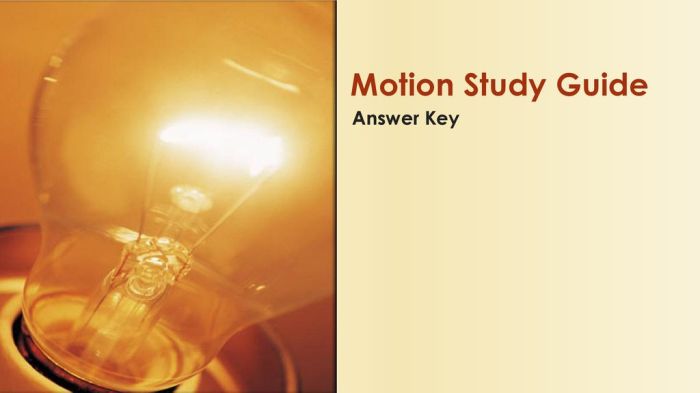Force and motion study guide answer key unlocks the door to a captivating world of physics, where the interplay of forces and motion governs the universe around us. This comprehensive guide provides a roadmap to understanding the fundamental concepts, applications, and misconceptions associated with force and motion, empowering readers with a solid foundation in this fascinating field.
Delving into the intricacies of force and motion, this guide explores the different types of forces, their relationship with mass and acceleration, and their impact on everyday situations. It unravels the complexities of motion, encompassing linear, circular, and projectile motion, and elucidates the concepts of displacement, velocity, and acceleration.
Furthermore, the guide sheds light on friction and air resistance, examining their effects on motion and the role they play in shaping our physical world.
Force and Motion Concepts

Force is a physical quantity that describes an interaction that can change the motion of an object. It is a vector quantity, meaning it has both magnitude and direction. There are different types of forces, such as contact forces (e.g.,
friction, normal force), non-contact forces (e.g., gravity, magnetic force), and applied forces (e.g., push, pull).
Newton’s Second Law states that the acceleration of an object is directly proportional to the net force acting on it and inversely proportional to its mass. Mathematically, it is expressed as F = ma, where F is the net force, m is the mass, and a is the acceleration.
Examples of forces acting in everyday situations include:
- When you push a door open, you apply a force to the door, causing it to move.
- When you drop a ball, gravity pulls the ball towards the ground, causing it to accelerate downwards.
- When you rub your hands together, friction between your hands creates heat.
Motion and its Measurement: Force And Motion Study Guide Answer Key
Motion is a change in the position of an object over time. There are different types of motion, such as linear motion (movement in a straight line), circular motion (movement in a circle), and projectile motion (movement of an object thrown into the air).
Displacement is the distance and direction of an object’s movement from its starting point. Velocity is the rate of change of displacement, and acceleration is the rate of change of velocity.
Methods for measuring and calculating motion parameters include:
- Using a ruler or measuring tape to measure displacement.
- Using a stopwatch to measure time.
- Using the equations of motion to calculate velocity and acceleration.
Friction and Air Resistance
Friction is a force that opposes the relative motion of two surfaces in contact. There are different types of friction, such as static friction (when two surfaces are not moving relative to each other), kinetic friction (when two surfaces are moving relative to each other), and rolling friction (when an object rolls on a surface).
Friction affects motion by reducing the speed of moving objects. It is also responsible for generating heat, as when you rub your hands together.
Air resistance is a force that opposes the motion of an object through a fluid (such as air or water). It is proportional to the velocity of the object and the density of the fluid.
Applications of Force and Motion

Force and motion principles are applied in a wide range of fields, including engineering, sports, and daily life.
Some examples of applications include:
| Application | Force Involved | Motion Result |
|---|---|---|
| Walking | Gravitational force, ground reaction force | Forward movement |
| Driving a car | Engine force, friction force | Acceleration, deceleration, turning |
| Building a bridge | Gravitational force, tension force, compression force | Support and stability of the bridge |
Common Misconceptions
There are some common misconceptions about force and motion. Here are a few examples:
- Misconception:Heavier objects fall faster than lighter objects. Correct Understanding:In a vacuum, all objects fall at the same rate, regardless of their mass.
- Misconception:Force is always applied by one object to another. Correct Understanding:Force can also be applied by fields, such as the gravitational field.
- Misconception:Motion is always caused by a force. Correct Understanding:Motion can also be caused by inertia.
FAQ Overview
What is the relationship between force, mass, and acceleration?
Force is directly proportional to mass and acceleration, as described by Newton’s second law (F = ma).
How does friction affect motion?
Friction opposes motion, reducing the velocity and acceleration of moving objects.
What is the difference between displacement, velocity, and acceleration?
Displacement measures the change in position, velocity measures the rate of change in displacement, and acceleration measures the rate of change in velocity.
